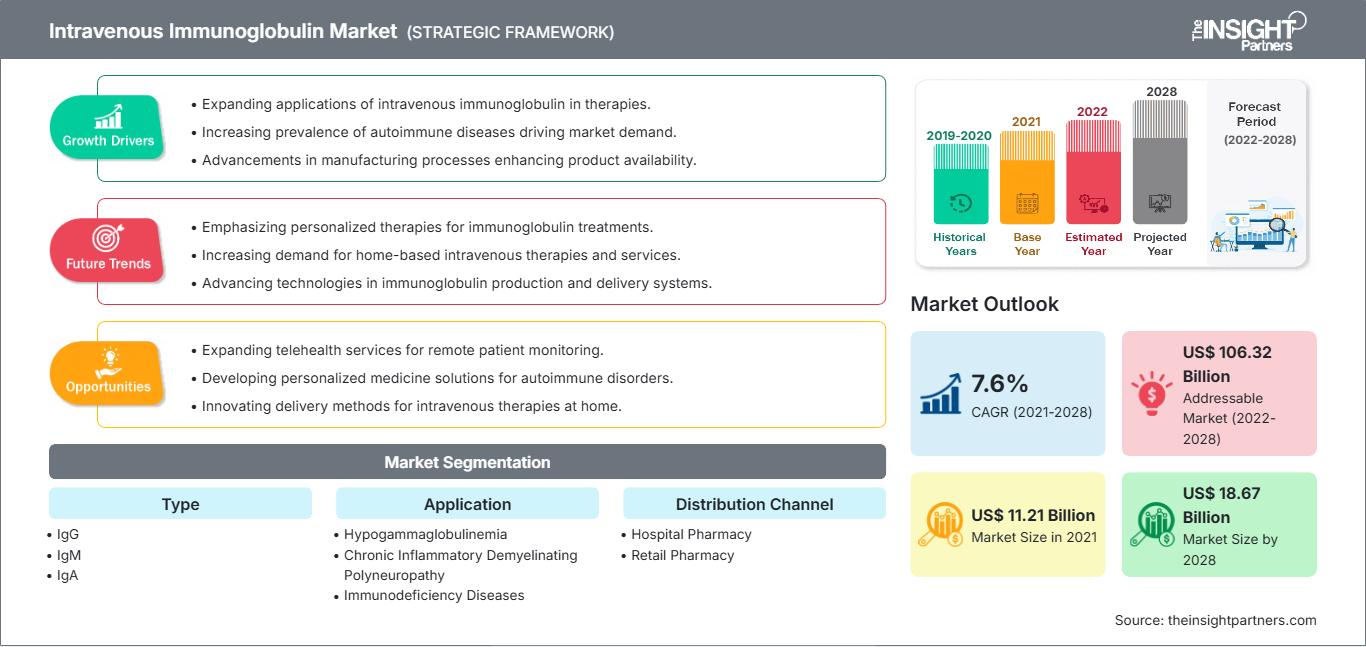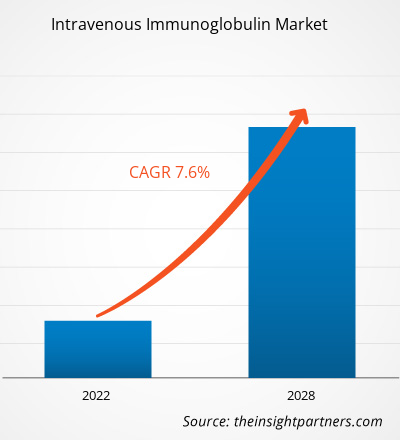Il mercato delle immunoglobuline per via endovenosa è stato valutato a 11.206,54 milioni di dollari nel 2021 e si prevede che raggiungerà un valore di 18.672,55 milioni di dollari entro il 2028; si stima una crescita a un CAGR del 7,6% dal 2022 al 2028.
Le immunoglobuline sono anticorpi prodotti naturalmente dal sistema immunitario dell'organismo, che aiutano a combattere infezioni e malattie. La carenza di immunoglobuline richiede la somministrazione esterna di immunoglobuline ed è nota come terapia sostitutiva con immunoglobuline (IgRT). Le IgRT possono essere somministrate per via endovenosa e sottocutanea. Le immunoglobuline per via endovenosa (IVIg) e le immunoglobuline per via sottocutanea (SCIg) vengono selezionate in base all'indicazione e alla gravità. Le IVIg sono prodotte dal plasma umano. Contiene anticorpi e viene utilizzato per trattare un numero crescente di malattie immunologiche, ematologiche e neurologiche.
Il mercato delle immunoglobuline per via endovenosa è segmentato in base a tipologia, applicazione, canale di distribuzione, utente finale e area geografica. Per area geografica, il mercato è ampiamente suddiviso in Nord America, Europa, Asia-Pacifico, Medio Oriente e Africa e America meridionale e centrale. Questo rapporto offre approfondimenti e analisi approfondite del mercato, evidenziando parametri quali tendenze di mercato, dinamiche di mercato e analisi competitiva dei principali attori del mercato a livello globale.
Personalizza questo rapporto in base alle tue esigenze
Potrai personalizzare gratuitamente qualsiasi rapporto, comprese parti di questo rapporto, o analisi a livello di paese, pacchetto dati Excel, oltre a usufruire di grandi offerte e sconti per start-up e università
Mercato delle immunoglobuline per via endovenosa: Approfondimenti strategici

- Ottieni le principali tendenze chiave del mercato di questo rapporto.Questo campione GRATUITO includerà l'analisi dei dati, che vanno dalle tendenze di mercato alle stime e alle previsioni.
Potrai personalizzare gratuitamente qualsiasi rapporto, comprese parti di questo rapporto, o analisi a livello di paese, pacchetto dati Excel, oltre a usufruire di grandi offerte e sconti per start-up e università
Mercato delle immunoglobuline per via endovenosa: Approfondimenti strategici

- Ottieni le principali tendenze chiave del mercato di questo rapporto.Questo campione GRATUITO includerà l'analisi dei dati, che vanno dalle tendenze di mercato alle stime e alle previsioni.
Approfondimenti di mercato
La crescente prevalenza delle malattie da immunodeficienza e l'aumento della popolazione geriatrica stanno trainando il mercato delle immunoglobuline per via endovenosa.
Secondo il National Institute of Allergy and Infectious Diseases (NIAID), oltre 200 diversi tipi di malattie da immunodeficienza primaria (PIDD) colpiscono circa 500.000 persone negli Stati Uniti. Queste rare malattie genetiche possono essere croniche, lievi e costose. La trombocitopenia immune (ITP) è una malattia emorragica autoimmune caratterizzata da livelli anormalmente bassi di piastrine; una condizione nota come trombocitopenia. Secondo la Rare Diseases Organization, ogni anno vengono registrati circa 200.000 casi di ITP in tutto il mondo. Inoltre, secondo il rapporto World Population Prospects 2019 della Divisione Popolazione delle Nazioni Unite, i paesi asiatici ed europei hanno alcune delle popolazioni più anziane al mondo, con un'età pari o superiore a 65 anni. Il Giappone è al primo posto con il 28%, seguito dall'Italia con il 23%. Inoltre, Finlandia, Portogallo e Grecia sono tra i primi cinque paesi con una popolazione anziana inferiore al 22%. Molti dei pazienti trattati con IVIg hanno più di 60 anni. Con l'invecchiamento, la capacità di produrre linfociti T per combattere le malattie si riduce significativamente. Pertanto, l'organismo di una persona anziana è facilmente soggetto a diverse infezioni e malattie, il che aumenta la domanda di terapie immunitarie che prevedono l'uso di IVIg. Pertanto, l'aumento delle malattie da immunodeficienza e la crescita della popolazione geriatrica in tutto il mondo stanno rafforzando il mercato delle immunoglobuline per via endovenosa.
Approfondimenti basati sul tipo
In base al tipo, il mercato delle immunoglobuline per via endovenosa è segmentato in IgG, IgM, IgA, IgE e IgD. Il segmento delle immunoglobuline di tipo IgG ha detenuto la quota di mercato maggiore nel 2021. Tuttavia, si prevede che il segmento portatile registrerà il CAGR più elevato durante il periodo di previsione, grazie all'ampia applicazione delle IgG nel trattamento di diverse categorie di disturbi.
Approfondimenti basati sull'applicazione
In base all'applicazione, il mercato delle immunoglobuline per via endovenosa è segmentato in ipogammaglobulinemia, polineuropatia demielinizzante infiammatoria cronica, malattie da immunodeficienza, miastenia grave, neuropatia motoria multifocale, porpora trombocitopenica idiopatica, miopatie infiammatorie, deficit di anticorpi specifici, sindrome di Guillain-Barré e altre. Nel 2021, il segmento delle malattie da immunodeficienza ha detenuto la quota di mercato maggiore. Inoltre, si prevede che lo stesso segmento registrerà una crescita della domanda al CAGR più rapido dal 2022 al 2028, a causa della crescente prevalenza di malattie da immunodeficienza e dell'aumento delle approvazioni FDA per i prodotti IVIg per il trattamento dell'immunodeficienza.
Approfondimenti basati sul canale di distribuzione
In base al canale di distribuzione, il mercato delle immunoglobuline per via endovenosa è segmentato in farmacie ospedaliere, farmacie al dettaglio e altri. Nel 2021, il segmento delle farmacie ospedaliere deteneva la quota maggiore del mercato. Inoltre, si prevede che il segmento delle farmacie al dettaglio registrerà una crescita della domanda al CAGR più rapido dal 2022 al 2028, grazie all'espansione delle farmacie al dettaglio e allo spostamento del comportamento dei consumatori verso farmacie al dettaglio organizzate che offrono farmaci e medicinali di alta qualità.
Approfondimenti basati sull'utente finale
In base all'utente finale, il mercato delle immunoglobuline per via endovenosa è segmentato in ospedali, cliniche specialistiche e altri. Nel 2021, il segmento ospedaliero deteneva la quota maggiore del mercato. Inoltre, si prevede che il segmento delle cliniche specialistiche registrerà una crescita della domanda al CAGR più rapido dal 2022 al 2028, grazie ai progressi delle cliniche specialistiche nell'offerta di IgRT rapide e accurate ai pazienti.
Sviluppi organici come le approvazioni dei prodotti sono strategie ampiamente adottate dagli operatori globali del mercato delle immunoglobuline per via endovenosa. Di seguito sono elencati alcuni dei recenti sviluppi chiave del mercato:
- A marzo 2022, ADMA Biologics, Inc. ha annunciato l'approvazione della Food and Drug Administration (FDA) degli Stati Uniti per estendere la data di scadenza da 24 a 36 mesi per i suoi farmaci immunoglobuline (“IG”) ASCENIV e BIVIGAM conservati a 2-8 °C. L'estensione della data di scadenza si applica a tutti i lotti di ASCENIV e BIVIGAM esistenti attualmente nella catena di fornitura commerciale, nonché alla futura produzione di ASCENIV e BIVIGAM in tutte le dimensioni di fiala, scale di produzione e prodotti farmaceutici finiti con riempimento interno ed esterno.
- A giugno 2021, Octapharma ha annunciato che l'octagam 10%, un'immunoglobulina endovenosa derivata dal plasma umano (IVIg), ha recentemente ottenuto l'approvazione nell'Unione Europea (UE) come terapia immunomodulatrice per adulti affetti da dermatomiosite. In seguito all'approvazione dell'UE, l'octagam 10% ha ricevuto l'approvazione nazionale in Germania l'11 maggio 2021, con l'approvazione prevista a breve anche negli altri stati membri europei.
- Nell'aprile 2021, ADMA Biologics, Inc. ha annunciato che la Food and Drug Administration (FDA) statunitense ha approvato il processo di produzione ampliato dell'azienda, consentendo il frazionamento e la purificazione di un pool di plasma da 4.400 litri per la produzione di immunoglobuline per via endovenosa (IVIG).
- Nel febbraio 2020, CSL Behring ha annunciato che la Food and Drug Administration (FDA) statunitense ha concesso a Privigen (immunoglobulina per via endovenosa (umana), 10% liquida) la designazione di farmaco orfano come terapia sperimentale nel trattamento della sclerosi sistemica (SSc).
Tali sviluppi da parte degli operatori del mercato stanno guidando l'immunoglobulina per via endovenosa mercato.
Approfondimenti regionali sul mercato delle immunoglobuline per via endovenosa
Le tendenze regionali e i fattori che influenzano il mercato delle immunoglobuline per via endovenosa durante il periodo di previsione sono stati ampiamente spiegati dagli analisti di The Insight Partners. Questa sezione illustra anche i segmenti e la geografia del mercato delle immunoglobuline per via endovenosa in Nord America, Europa, Asia-Pacifico, Medio Oriente e Africa, America meridionale e centrale.
Ambito del rapporto sul mercato delle immunoglobuline per via endovenosa
| Attributo del rapporto | Dettagli |
|---|---|
| Dimensioni del mercato in 2021 | US$ 11.21 Billion |
| Dimensioni del mercato per 2028 | US$ 18.67 Billion |
| CAGR globale (2021 - 2028) | 7.6% |
| Dati storici | 2019-2020 |
| Periodo di previsione | 2022-2028 |
| Segmenti coperti |
By Tipo
|
| Regioni e paesi coperti | Nord America
|
| Leader di mercato e profili aziendali chiave |
|
Densità degli operatori del mercato delle immunoglobuline per via endovenosa: comprendere il suo impatto sulle dinamiche aziendali
Il mercato delle immunoglobuline per via endovenosa è in rapida crescita, trainato dalla crescente domanda da parte degli utenti finali, dovuta a fattori quali l'evoluzione delle preferenze dei consumatori, i progressi tecnologici e una maggiore consapevolezza dei benefici del prodotto. Con l'aumento della domanda, le aziende stanno ampliando la propria offerta, innovando per soddisfare le esigenze dei consumatori e sfruttando le tendenze emergenti, alimentando ulteriormente la crescita del mercato.

- Ottieni il Mercato delle immunoglobuline per via endovenosa Panoramica dei principali attori chiave
Immunoglobuline per via endovenosa - Segmentazione del mercato
Il mercato globale delle immunoglobuline per via endovenosa è segmentato in base a tipologia, applicazione, canale di distribuzione, utente finale e area geografica. In base alla tipologia, il mercato è segmentato in IgG, IgM, IgA, IgE e IgD. Per applicazione, il mercato è segmentato in ipogammaglobulinemia, polineuropatia demielinizzante infiammatoria cronica, malattie da immunodeficienza, miastenia grave, neuropatia motoria multifocale, porpora trombocitopenica idiopatica, miopatie infiammatorie, deficit di anticorpi specifici, sindrome di Guillain-Barré e altre. In base al canale di distribuzione, il mercato è segmentato in farmacie ospedaliere, farmacie al dettaglio e altre. Per utente finale, il mercato è segmentato in ospedali, cliniche specialistiche e altre. In base alla geografia, il mercato è segmentato in Nord America, Europa, Asia Pacifico, Medio Oriente e Africa e America meridionale e centrale.
Profili aziendali
- Takeda Pharmaceutical Company Limited
- Grifols, SA
- Pfizer Inc.
- ADMA Biologics Inc.
- Bio Products Laboratory Ltd.
- Shanghai RAAS
- Octapharma AG
- Kedrion SpA
- CSL Behring (CSL Limited)
- Prothya Biosolutions BV
- Analisi storica (2 anni), anno base, previsione (7 anni) con CAGR
- Analisi PEST e SWOT
- Valore/volume delle dimensioni del mercato - Globale, Regionale, Nazionale
- Industria e panorama competitivo
- Set di dati Excel
Report recenti
Testimonianze
Motivo dell'acquisto
- Processo decisionale informato
- Comprensione delle dinamiche di mercato
- Analisi competitiva
- Analisi dei clienti
- Previsioni di mercato
- Mitigazione del rischio
- Pianificazione strategica
- Giustificazione degli investimenti
- Identificazione dei mercati emergenti
- Miglioramento delle strategie di marketing
- Aumento dell'efficienza operativa
- Allineamento alle tendenze normative




















 Ottieni un campione gratuito per - Mercato delle immunoglobuline per via endovenosa
Ottieni un campione gratuito per - Mercato delle immunoglobuline per via endovenosa